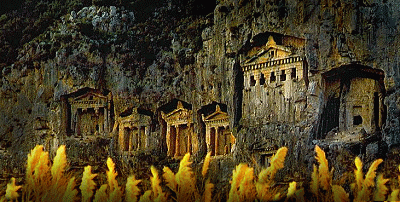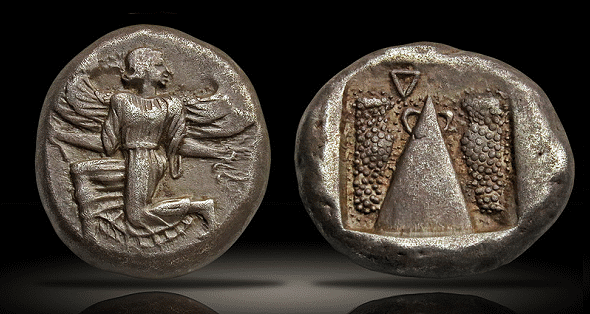Kaunos Coinage By Russell A. Augustin, AU Capital Management, LLC ……
The Colosseo Collection ……
Kaunos was a prominent trading center in Asia Minor alongside Lycia and Caria. It was mentioned by ancient authors specifically because of how its customs and language differed from Caria. Until recently, it was not possible to decisively attribute any archaic or classical Kaunos coinage, which is unusual considering its importance during these periods.
 Thanks to the persistence of academics and archaeologists across the world, our understanding of ancient coin history is constantly evolving. This Kaunos Coinage is a perfect example: until the 1980s, little was understood about the Carian language. Egyptologists were able to aid in the deciphering, using Carian inscriptions found in Egypt to cross-reference and to begin to comprehend the language, allowing us to better understand the coins of the region.
Thanks to the persistence of academics and archaeologists across the world, our understanding of ancient coin history is constantly evolving. This Kaunos Coinage is a perfect example: until the 1980s, little was understood about the Carian language. Egyptologists were able to aid in the deciphering, using Carian inscriptions found in Egypt to cross-reference and to begin to comprehend the language, allowing us to better understand the coins of the region.
While the obverse of this coin has similar attributes to the goddess Nike, the latest research into the customs of the region indicates that it is in fact the Greek goddess Iris, the messenger of Hera. Unlike Nike, and as shown on this coin, Iris is generally shown holding a kerykeion (also known as a caduceus: a “herald’s staff”, a symbol of a messenger) and a wreath in either hand.
The attribution of the obverse as Iris has aided in interpreting the reverse. The series featured a reverse which evolved over time, beginning with a crude triangular punch mark, then as a central device with horn-like tags, and eventually with handles as depicted in this coin.

While originally thought to be either an early incuse pattern or perhaps a relief map like similar coinage from Ionia, it is now believed that the reverse depicts a sacred stone. In antiquity, it would have been referred to as a baetyl, or “beth el” in Aramaic, meaning “House of the God”. This term is used to describe conical stones which were worshipped as embodiments of the gods. These objects are found fairly regularly on Roman provincial coins but are very unusual on early, archaic coinage.
Archaeologists have long been mystified by the presence of a round building near the harbor of Kaunos. Recently, about three meters beneath the surface in the center of the building, a large conical piece of limestone measuring 12 feet high and five feet wide was discovered.
The bottom of this object stands on the bedrock and was buried as a counterbalance to the top, which towered nearly eight feet in the air. While remaining accessible to worshippers in the fifth century BCE, it was eventually enclosed in walls and shrines to protect the sacred stone. With stone worship now having been confirmed in multiple aspects of life in Kaunos, there can be little doubt that the reverse of these coins depicts a sacred stone, likely the exact one uncovered inside the round building.
This particular coin appears to show handles on both sides which may have been used to carry the sacred stone during processions prior to it being enclosed in its final shrine in the fourth century BCE. With artistry evolving and improving alongside the refinement of their beliefs, the dies became more intricate with this coin showing subtle depth to the conical shape rather than just a flat triangle as seen on earlier varieties.
Many sacred stones are meteorites, believed to have been sent by the gods, and it is likely that the conical limestone encapsulated the original meteorite. As further evidence of the stone being a meteorite, the god Iris is known as the god of rainbows, noting her connection between the sky and earth and likely referring to the event of the meteorite falling. Meteorite impacts represented a confusing and important event that nearly every ancient culture interpreted as a message or visit from the gods.
Over the span of several decades, the reverse eventually transformed into stylized birds followed by two bunches of grapes rendered in dots, potentially coinciding with a shift in religious customs and a movement away from archaic art.
* * *
CARIA, Kaunos. Circa 450-430 BCE. AR Stater (18mm, 11.49 g, 9h). Winged female figure in kneeling-running stance left, head right, holding kerykeion and wreath / Baetyl, with handles at apex; inverted Δ (K in Carian) to upper left, pelleted fields at sides; all within incuse square. Konuk 90 (O33/R31); Konuk, Coin M24; Troxell, Winged 25 (same dies); SNG Keckman 824 (same obv. die); SNG von Aulock 2347; BMC Cilicia 5 (Mallos, same dies). Good VF, toned. Ex Bowers & Ruddy FPL (Fall 1980), no. 41.




